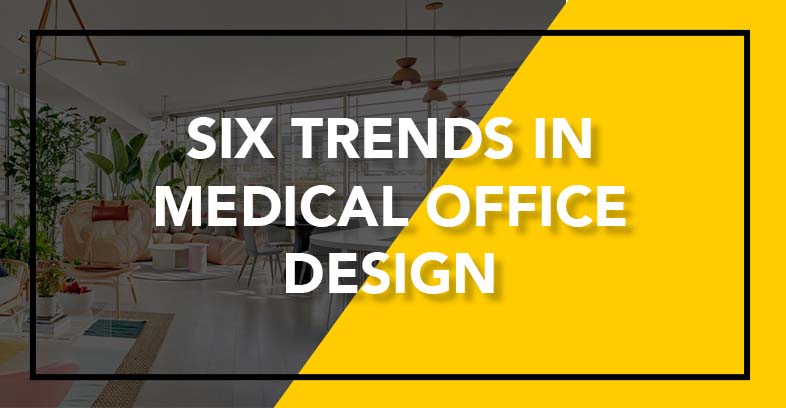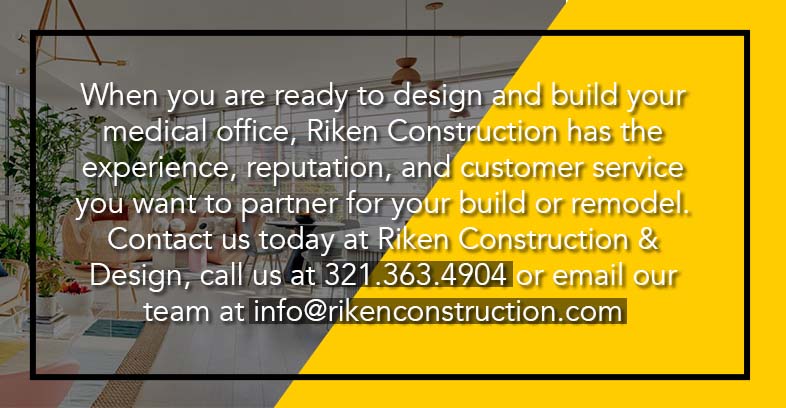
Visiting a medical office can be uncomfortable and stressful. Creating the right environment is essential to easing that stress and creating a positive patient experience. Gone are the days of the bland and sterile-looking offices. Today’s medical facilities have a more soothing and relaxing atmosphere. Many are incorporating nature, bold colors, technology, and interior design trends creating a more warm and safe space. When you create an inviting space and put your clients at ease, they are more likely to return.
Many modern-day medical office design trends stem from the desire to create a positive experience for both the patient and the staff. When building or remodeling your medical office, some elements to consider are patient areas, colors, furniture, design elements, technology, and sustainability. Many newly constructed or remodeled offices are beautiful and have many of the same design elements you see in a home or commercial office.
FIRST IMPRESSIONS ARE IMPORTANT
First impressions are important, and setting the tone for your office begins when your patients and staff walk through the door. This space includes your reception area, waiting area, and sometimes restroom. Understanding that your reception area is the heartbeat of your practice is key to setting the correct tone.

The size of the reception area you create will be proportional to the type and size of your practice. You will want to take into consideration your typical patient. For instance, a pediatrician’s office will be designed to appeal to children and adults. Elements that are found in the area are a reception desk, seating for patients, an interactive area for children, retail space (depending on the type of practice), and tables for magazines and literature.

Your reception desk needs to be inviting, provide privacy and be aesthetically pleasing. When considering privacy, take both the in-person patient and the patient calling into the practice. The desk of the reception area should provide enough space for your staff to efficiently complete their work but also have enough storage to keep necessary items out of sight. A clean and tidy area is important and shows your patients that your practice is organized and efficient.

The waiting area is a space where your patients spend a significant amount of time. You want it to be comfortable, consider personal space, include natural light if possible, and a wide range of seating options. Including seat options that vary in size, are ergonomically correct, and easy to clean, creating an inclusive space and a better patient experience. You may also want to consider the space to include areas for contagious patients. Many waiting areas also now include technology such as televisions(informational, entertainment) and charging stations. Pediatrician offices also include interactive areas for children.

One area that is often overlooked is the hallways of the office. These areas are another opportunity to create a space that feels relaxing and stress-free. A combination of color, lighting and interior design can keep these transition spaces in harmony with the other office parts.

Patient rooms require enough space for the physician, nurse, patient, and anyone accompanying the patient. You want your patient rooms to include any necessary equipment and space to store supplies. It is also imperative that your patient rooms be designed to include noise control and be easily cleaned in between patients.
Many offices also include adaptable spaces that can be used for triage, patient appointments, and patient instruction.
Depending on your practices check-in and check-out procedures, you will want to decide if you require a check-out area in your office.
When choosing the color palette for your office, you want to consider how colors affect people. Using some colors like red or all white can create fear and uneasiness. However, pastel colors are more soothing, and colors like bright yellow can invoke happiness. A recent study indicates that a soft blue can calm a rapid heart rate. It is important to remember that this space is not about personal favorites but about increasing your patient experience and reflecting trust and professionalism.

Lighting is another essential element in your office. Designing the office to utilize natural light is the preference, but if that is not possible, you want to include softer light choices than harsh bright options. Utilizing LED lighting to create a more natural feel is the goal when you don’t have access to natural light.

Another design trend that is trending in newly constructed and remodeled offices is biophilic design, which seeks to incorporate natural elements indoors. Whether you include live plants, views of the outdoors, nature color pallets, or murals, this trend seems to be here to stay.
Medical office design has transformed over the last few years, moving from impersonal and clinical to unique and inviting spaces that make the patient feel welcome, less stressed, and evoke a positive experience.
Riken Construction understands the nuances of designing and constructing medical office spaces and would love to partner with your practice to bring your vision to life.

______________________________
Riken Construction and Design, LLC. provides our clients with the highest level of quality construction and consulting services at fair and market-competitive rates. Our pledge is to establish lasting relationships with our customers by exceeding their expectations and gaining their trust through exceptional performance by every member of the construction team. To fulfill our goal, we treat all employees fairly and involve them in the quality improvement process to insure responsiveness and cost-effective work practices. Our clients count on our dependability, our drive, and our integrity. We take great pride in our accomplishments and build on them every day. To learn more about Riken Construction, call us at 321.363.4904 or email [email protected].
 Visiting a medical office can be uncomfortable and stressful. Creating the right environment is essential to easing that stress and creating a positive patient experience. Gone are the days of the bland and sterile-looking offices. Today’s medical facilities have a more soothing and relaxing atmosphere. Many are incorporating nature, bold colors, technology, and interior design trends creating a more warm and safe space. When you create an inviting space and put your clients at ease, they are more likely to return.
Many modern-day medical office design trends stem from the desire to create a positive experience for both the patient and the staff. When building or remodeling your medical office, some elements to consider are patient areas, colors, furniture, design elements, technology, and sustainability. Many newly constructed or remodeled offices are beautiful and have many of the same design elements you see in a home or commercial office.
Visiting a medical office can be uncomfortable and stressful. Creating the right environment is essential to easing that stress and creating a positive patient experience. Gone are the days of the bland and sterile-looking offices. Today’s medical facilities have a more soothing and relaxing atmosphere. Many are incorporating nature, bold colors, technology, and interior design trends creating a more warm and safe space. When you create an inviting space and put your clients at ease, they are more likely to return.
Many modern-day medical office design trends stem from the desire to create a positive experience for both the patient and the staff. When building or remodeling your medical office, some elements to consider are patient areas, colors, furniture, design elements, technology, and sustainability. Many newly constructed or remodeled offices are beautiful and have many of the same design elements you see in a home or commercial office.
 The size of the reception area you create will be proportional to the type and size of your practice. You will want to take into consideration your typical patient. For instance, a pediatrician’s office will be designed to appeal to children and adults. Elements that are found in the area are a reception desk, seating for patients, an interactive area for children, retail space (depending on the type of practice), and tables for magazines and literature.
The size of the reception area you create will be proportional to the type and size of your practice. You will want to take into consideration your typical patient. For instance, a pediatrician’s office will be designed to appeal to children and adults. Elements that are found in the area are a reception desk, seating for patients, an interactive area for children, retail space (depending on the type of practice), and tables for magazines and literature.
 Your reception desk needs to be inviting, provide privacy and be aesthetically pleasing. When considering privacy, take both the in-person patient and the patient calling into the practice. The desk of the reception area should provide enough space for your staff to efficiently complete their work but also have enough storage to keep necessary items out of sight. A clean and tidy area is important and shows your patients that your practice is organized and efficient.
Your reception desk needs to be inviting, provide privacy and be aesthetically pleasing. When considering privacy, take both the in-person patient and the patient calling into the practice. The desk of the reception area should provide enough space for your staff to efficiently complete their work but also have enough storage to keep necessary items out of sight. A clean and tidy area is important and shows your patients that your practice is organized and efficient.
 The waiting area is a space where your patients spend a significant amount of time. You want it to be comfortable, consider personal space, include natural light if possible, and a wide range of seating options. Including seat options that vary in size, are ergonomically correct, and easy to clean, creating an inclusive space and a better patient experience. You may also want to consider the space to include areas for contagious patients. Many waiting areas also now include technology such as televisions(informational, entertainment) and charging stations. Pediatrician offices also include interactive areas for children.
The waiting area is a space where your patients spend a significant amount of time. You want it to be comfortable, consider personal space, include natural light if possible, and a wide range of seating options. Including seat options that vary in size, are ergonomically correct, and easy to clean, creating an inclusive space and a better patient experience. You may also want to consider the space to include areas for contagious patients. Many waiting areas also now include technology such as televisions(informational, entertainment) and charging stations. Pediatrician offices also include interactive areas for children.
 One area that is often overlooked is the hallways of the office. These areas are another opportunity to create a space that feels relaxing and stress-free. A combination of color, lighting and interior design can keep these transition spaces in harmony with the other office parts.
One area that is often overlooked is the hallways of the office. These areas are another opportunity to create a space that feels relaxing and stress-free. A combination of color, lighting and interior design can keep these transition spaces in harmony with the other office parts.
 Patient rooms require enough space for the physician, nurse, patient, and anyone accompanying the patient. You want your patient rooms to include any necessary equipment and space to store supplies. It is also imperative that your patient rooms be designed to include noise control and be easily cleaned in between patients.
Many offices also include adaptable spaces that can be used for triage, patient appointments, and patient instruction.
Depending on your practices check-in and check-out procedures, you will want to decide if you require a check-out area in your office.
When choosing the color palette for your office, you want to consider how colors affect people. Using some colors like red or all white can create fear and uneasiness. However, pastel colors are more soothing, and colors like bright yellow can invoke happiness. A recent study indicates that a soft blue can calm a rapid heart rate. It is important to remember that this space is not about personal favorites but about increasing your patient experience and reflecting trust and professionalism.
Patient rooms require enough space for the physician, nurse, patient, and anyone accompanying the patient. You want your patient rooms to include any necessary equipment and space to store supplies. It is also imperative that your patient rooms be designed to include noise control and be easily cleaned in between patients.
Many offices also include adaptable spaces that can be used for triage, patient appointments, and patient instruction.
Depending on your practices check-in and check-out procedures, you will want to decide if you require a check-out area in your office.
When choosing the color palette for your office, you want to consider how colors affect people. Using some colors like red or all white can create fear and uneasiness. However, pastel colors are more soothing, and colors like bright yellow can invoke happiness. A recent study indicates that a soft blue can calm a rapid heart rate. It is important to remember that this space is not about personal favorites but about increasing your patient experience and reflecting trust and professionalism.
 Lighting is another essential element in your office. Designing the office to utilize natural light is the preference, but if that is not possible, you want to include softer light choices than harsh bright options. Utilizing LED lighting to create a more natural feel is the goal when you don’t have access to natural light.
Lighting is another essential element in your office. Designing the office to utilize natural light is the preference, but if that is not possible, you want to include softer light choices than harsh bright options. Utilizing LED lighting to create a more natural feel is the goal when you don’t have access to natural light.
 Another design trend that is trending in newly constructed and remodeled offices is biophilic design, which seeks to incorporate natural elements indoors. Whether you include live plants, views of the outdoors, nature color pallets, or murals, this trend seems to be here to stay.
Medical office design has transformed over the last few years, moving from impersonal and clinical to unique and inviting spaces that make the patient feel welcome, less stressed, and evoke a positive experience.
Riken Construction understands the nuances of designing and constructing medical office spaces and would love to partner with your practice to bring your vision to life.
Another design trend that is trending in newly constructed and remodeled offices is biophilic design, which seeks to incorporate natural elements indoors. Whether you include live plants, views of the outdoors, nature color pallets, or murals, this trend seems to be here to stay.
Medical office design has transformed over the last few years, moving from impersonal and clinical to unique and inviting spaces that make the patient feel welcome, less stressed, and evoke a positive experience.
Riken Construction understands the nuances of designing and constructing medical office spaces and would love to partner with your practice to bring your vision to life.
 ______________________________
Riken Construction and Design, LLC. provides our clients with the highest level of quality construction and consulting services at fair and market-competitive rates. Our pledge is to establish lasting relationships with our customers by exceeding their expectations and gaining their trust through exceptional performance by every member of the construction team. To fulfill our goal, we treat all employees fairly and involve them in the quality improvement process to insure responsiveness and cost-effective work practices. Our clients count on our dependability, our drive, and our integrity. We take great pride in our accomplishments and build on them every day. To learn more about Riken Construction, call us at 321.363.4904 or email [email protected].
______________________________
Riken Construction and Design, LLC. provides our clients with the highest level of quality construction and consulting services at fair and market-competitive rates. Our pledge is to establish lasting relationships with our customers by exceeding their expectations and gaining their trust through exceptional performance by every member of the construction team. To fulfill our goal, we treat all employees fairly and involve them in the quality improvement process to insure responsiveness and cost-effective work practices. Our clients count on our dependability, our drive, and our integrity. We take great pride in our accomplishments and build on them every day. To learn more about Riken Construction, call us at 321.363.4904 or email [email protected].


